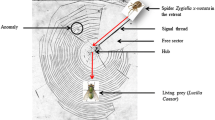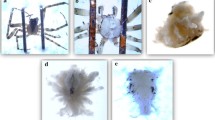Abstract
Leg loss is a common phenomenon in spiders, and according to the species 5% to 40% of the adults can present at least one missing leg. There is no possibility of regeneration after adult moult and the animal must manage with its missing appendages until its death. With the loss of one or more legs, female orb-weaving spiders can be penalized twice: firstly, because the legs are necessary for web construction and secondly, the legs are essential for the control of the prey after its interception by the web. During development, spiders may be also penalized because regeneration has energetic costs that take away resources for survival, growth and reproduction. All these consequences should influence negatively the development of the spider and thus its fitness. We investigated the impact of leg loss in the orb-weaving spider, Zygiella x-notata by studying its frequency in a natural population and web building and prey capture behaviours in laboratory. In field populations, 9.5% to 13%, of the adult females presented the loss of one or more legs; the majority of individuals had lost only one leg (in 48% of cases, a first one). Leg loss seems to affect all the adult spiders, as there is no difference of mass between intact spiders and those with missing leg. Data obtained with laboratory-reared spiders, showed that the loss of legs due to the moult is rare (less than 1%). Considering changes in web design, spiders with missing legs decreased their silk investment, increased the distance between spiral turns but did not change the capture surface of the web. Under our laboratory experimental conditions, spiders with one or two lost legs did not present any difference in prey capture efficiency. In laboratory conditions, spiders with lost leg(s) did not show any difference in egg sac production or in longevity (adult lifespan) compared to intact spiders.


Similar content being viewed by others
References
Amaya CC, Klawinski PD, Formanowicz DR (2001) The effects of leg autotomy on running speed and foraging ability in two species of wolf spider (Lycosidae). Am Midl Nat 145:201–205
Apontes P, Brown CA (2005) Between-sex variation in running speed and a potential cost of leg autotomy in the wolf spider Pirata sedentarius. Am Midl Nat 154:115–125
Bel-Venner MC, Venner S (2006) Mate-guarding strategies and male competitive ability in an orb-weaving spider: results from a field study. Anim Behav 71:1315–1322
Blackledge TA, Eliason CM (2007) Functionally independent components of prey capture are architecturally constrained in spider orb webs. Biol Lett 22:456–458
Blackledge TA, Zevengergen JM (2006) Mesh width influences prey retention in spider orb webs. Ethology 112:1194–1201
Brock RE, Smith LD (1998) Recovery of claw size and function following autotomy in Cancer productus (Decapoda: Brachyura). Biol Bull 194:53–62
Brueseke MA, Rypstra AL, Walker SE, Persons MH (2001) Leg autotomy in the wolf spider Pardosa milvina: a common phenomenon with apparent few costs. Am Midl Nat 146:153–160
Eisner T, Camazine S (1983) Spider leg autotomy induced by prey venom injection: an adaptative response to “pain”? Proc Natl Acad Sci Unit States Am 80:3382–3385
Fleming PA, Muller D, Bateman PW (2007) Leave it behind: a taxonomic perspective of autotomy in invertebrates. Biol Rev 82:481–510
Foelix RF (1996) Biology of spiders. Oxford University Press, Oxford
Formanowicz DR (1990) The antipredator efficacy of spider leg autotomy. Anim Behav 40:400–401
Fromhage L, Schneider J (2006) Emasculation to plug up females: the significance of pedipalp damage in Nephila fenestrata. Behav Ecol 10:353–356
Guffey C (1999) Costs associated with leg autotomy in the harvestmen Leiobunum nigripes and Leiobunum vittatum (Arachnida: Opiliones). Can J Zool 77:824–830
Herberstein ME, Heiling AM (1998) Does mesh height influence prey length in orb webs spiders (Araneae). Eur J Entomol 95:367–371
Johnson SA, Jakob EM (1999) Leg autotomy in a spider has minimal costs in competitive ability and development. Anim Behav 57:957–965
Krink T, Vollrath F (1999) A virtual robot to model the use of regenerated leg in a web- building spider. Anim Behav 57:223–232
Lutzy RM, Morse DH (2008) Effects of leg loss on male crab spiders Misumena vatia. Anim Behav 76:1519–1527
Maginnis TL (2006) The costs of autotomy and regeneration in animals: a review and framework for future research. Behav Ecol 17:857–872
Murakami Y (1983) Factors determining the prey size of the orb-web Argiope amoena (L. Koch) (Argiopidae). Oecologia 57:72–77
Roberts MJ (1996) Spiders of Britain and Northern Europe—Collins Field Guide. Harper Collins Publishers Ltd, London
Rypstra AL, Schmidt JM, Reif BD, DeVito J, Persons MH (2007) Tradeoffs involved in site selection and foraging in a wolf spider: effects of substrate structure and predation risk. Oikos 116:853–863
Sandoval CP (1994) Plasticity in web design in the spider Parawixia bistriata: a response to variable prey type. Funct Ecol 8:701–707
Scharf I, Lubin Y, Ovadia O (2010) Foraging decisions and behavioural flexibility in trap building predators: a review. Biol Rev Camb Philos Soc. doi:10.1111/j.1469-185X.2010.00163.x
Taylor PW, Roberts JA, Uetz GW (2006) Compensation for injury? Modified multi- modal courtship of wolf spiders following autotomy of signalling appendages. Ethol Ecol Evol 18:79–89
Uetz GW, McClintock WJ, Smith EI, Cook KK (1996) Limb regeneration and subsequent asymmetry in a male secondary sexual character influences sexual selection in wolf spiders. Zool Sci 6:927–933
Venner S, Casas J (2005) Spider webs designed for rare but life-saving catches. Pro R Soc B 272:1587–1592
Venner S, Thevenard L, Pasquet A, Leborgne R (2001) Estimation of the web's capture thread length in the orb-weaving spiders: determination of the most efficient formula. Ann Entomol Soc Am 94:490–496
Vollrath F (1987) Altered geometry of webs in spiders with regenerated leg. Nature 328:247–248
Vollrath F (1990) Leg regeneration in web spiders and its implication of Weaver phylogeny. Bull Brit Arachnol Soc 8:177–184
Witt PN, Reed CF, Peakall DB (1968) A spider's web, problems in regulatory biology. Springer, New York
Wrinn KM, Uetz GW (2007) Impacts of leg loss and regeneration on body condition, growth, and development time in the wolf spider Schizocosa ocreata. Can J Zool 85:823–831
Wrinn KM, Uetz GW (2008) Effects of autotomy and regeneration on detection and capture of prey in a generalist predator. Behav Ecol 19:1282–1288
Aknowledgements
This study has been conducted at the H. Poincaré Nancy University. We thank J. Marchal and L. Bahans who helped us collect and rear spiders in 2008 and 2009. Many thanks also to Dr. Y. Lubin, Dr. C. Gilbert and anonymous reviewers for their helpful comments on the manuscript.
Author information
Authors and Affiliations
Corresponding author
Additional information
Communicated by: Sven Thatje
Rights and permissions
About this article
Cite this article
Pasquet, A., Anotaux, M. & Leborgne, R. Loss of legs: is it or not a handicap for an orb-weaving spider?. Naturwissenschaften 98, 557–564 (2011). https://doi.org/10.1007/s00114-011-0799-7
Received:
Revised:
Accepted:
Published:
Issue Date:
DOI: https://doi.org/10.1007/s00114-011-0799-7




